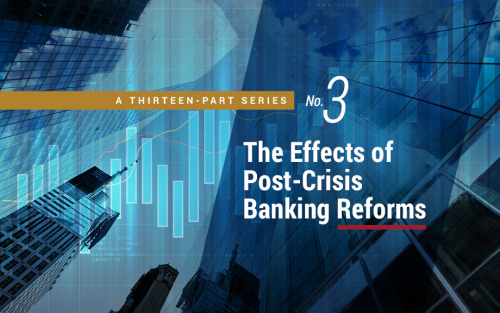Have the Risk Profiles of Large U.S. Bank Holding Companies Changed?

After the global financial crisis, regulatory changes were implemented to support financial stability, with some changes directly addressing capital and liquidity in bank holding companies (BHCs) and others targeting BHC size and complexity. Although the overall size of the largest U.S. BHCs has not decreased since the crisis, the organizational complexity of these same organizations has declined, with less notable changes being observed in their range of businesses and geographic scope (Goldberg and Meehl forthcoming). In this post, we explore how different types of BHC risks—risks that can influence the probability that a BHC is stressed, as well as the chance of systemic implications—have changed over time. The results are mixed: Levels of most BHC risks currently tend to be higher than in the years immediately preceding the crisis, but are markedly lower than the levels seen during and immediately following the crisis.
What’s in A(AA) Credit Rating?

Rising nonfinancial corporate business leverage, especially for riskier “high-yield” firms, has recently received increased public and supervisory scrutiny. For example, the Federal Reserve’s May 2019 Financial Stability Report notes that “growth in business debt has outpaced GDP for the past 10 years, with the most rapid growth in debt over recent years concentrated among the riskiest firms.” At the upper end of the credit spectrum, “investment-grade” firms have also increased their borrowing, while the number of higher-rated firms has decreased. In fact, there are currently only two U.S. companies rated AAA: Johnson & Johnson and Microsoft. In this post, we examine recent trends in the issuance of investment-grade corporate bonds and argue that the combination of increased BAA issuance and virtually nonexistent AAA issuance both reduces the usefulness of the BAA–AAA spread as a credit risk indicator and poses a financial stability concern.
Banking System Vulnerability: Annual Update

A key part of understanding the stability of the U.S. financial system is to monitor leverage and funding risks in the financial sector and the way in which these vulnerabilities interact to amplify negative shocks. In this post, we provide an update of four analytical models, introduced in a Liberty Street Economics post last year, that aim to capture different aspects of banking system vulnerability.
How Large Are Default Spillovers in the U.S. Financial System?

When a financial firm suffers sufficiently high losses, it might default on its counterparties, who may in turn become unable to pay their own creditors, and so on. This “domino” or “cascade” effect can quickly propagate through the financial system, creating undesirable spillovers and unnecessary defaults. In this post, we use the framework that we discussed in “Assessing Contagion Risk in a Financial Network,” the first part of this two-part series, to answer the question: How vulnerable is the U.S. financial system to default spillovers?
Assessing Contagion Risk in a Financial Network

Duarte, Jones, and Ruela describe how stress can propagate through the financial system and sketch out an approach for quantifying economic losses stemming from default cascades.
Understanding Cyber Risk: Lessons from a Recent Fed Workshop

Cyber risk poses a major threat to financial stability, yet financial institutions still lack consensus on the definition and terminology around cyber risk, and lack a common framework for confronting these hazards. This impedes efforts to measure and manage such risk, diminishing institutions’ individual and collective readiness to handle system-level cyber threats. In this blog post, we describe the proceedings of a recent workshop, where leading risk managers, academics, and policy makers gathered to discuss proposals for countering cyber risk. This workshop is part of a joint two-phase initiative between the Federal Reserve Banks of Richmond and New York and the Fed’s Board of Governors to harmonize cyber risk identification, classification, and measurement practices.
Resolving “Too Big to Fail”

Many market participants believe that large financial institutions enjoy an implicit guarantee that the government will step in to rescue them from potential failure. These “Too Big to Fail” (TBTF) issues became particularly salient during the 2008 crisis. From the government’s perspective, rescuing these financial institutions can be important to avoid harm to the financial system. The bailouts also artificially lower the risk borne by investors and the financing costs of big banks. The Dodd-Frank Act attempts to remove the incentive for governments to bail out banks in the first place by mandating that each large bank file a “living will” that details its strategy for a rapid and orderly resolution in the event of material distress or failure without disrupting the broader economy. In our recent New York Fed staff report, we look at whether living wills are effective at reducing the cost of implicit TBTF bailout subsidies.
Tax Reform’s Impact on Bank and Corporate Cyclicality

The Tax Cuts and Jobs Act (TCJA) is expected to increase after-tax profits for most companies, primarily by lowering the top corporate statutory tax rate from 35 percent to 21 percent. At the same time, the TCJA provides less favorable treatment of net operating losses and limits the deductibility of net interest expense. We explain how the latter set of changes may heighten bank and corporate borrower cyclicality by making bank capital and default risk for highly levered corporations more sensitive to economic downturns.
Good News, Leverage, and Sudden Stops

One of the major debates in open economy macroeconomics is the extent to which capital inflows are beneficial for growth. In principle, these flows allow countries to increase their consumption and investment spending beyond their income by enabling them to tap into foreign saving. Periods of such borrowing, however, are associated with large trade deficits, external debt accumulation, and, in some cases, overheating when these economies operate beyond their potential output level for an extended period of time. The relevant question in this context is whether the rate at which a country is taking on external debt has useful predictive information about financial crises.
Did the Dodd‑Frank Act End ‘Too Big to Fail’?

One goal of the Dodd-Frank Act of 2010 was to end “too big to fail.” Toward that goal, the Act required systemically important financial institutions to submit detailed plans for an orderly resolution (“living wills”) and authorized the FDIC to create an alternative resolution procedure. In response, the FDIC has developed a “single point of entry” (SPOE) strategy, under which healthy parent companies bear the losses of their failing subsidiaries. Since SPOE makes the parent company responsible for subsidiaries’ losses, we would expect parents to become riskier, relative to their subsidiaries, compared to before the announcement of the SPOE strategy in December 2013. Do bond raters and investors share this view?














 RSS Feed
RSS Feed Follow Liberty Street Economics
Follow Liberty Street Economics